VIEW BY CATEGORY:
Hi, we're Hunter and Sarah, a husband-and-wife, luxury wedding photography team. We’re also educators, helping other photographers build profitable and sustainable photography businesses.
MEET US
LOOKING FOR SOMETHING?
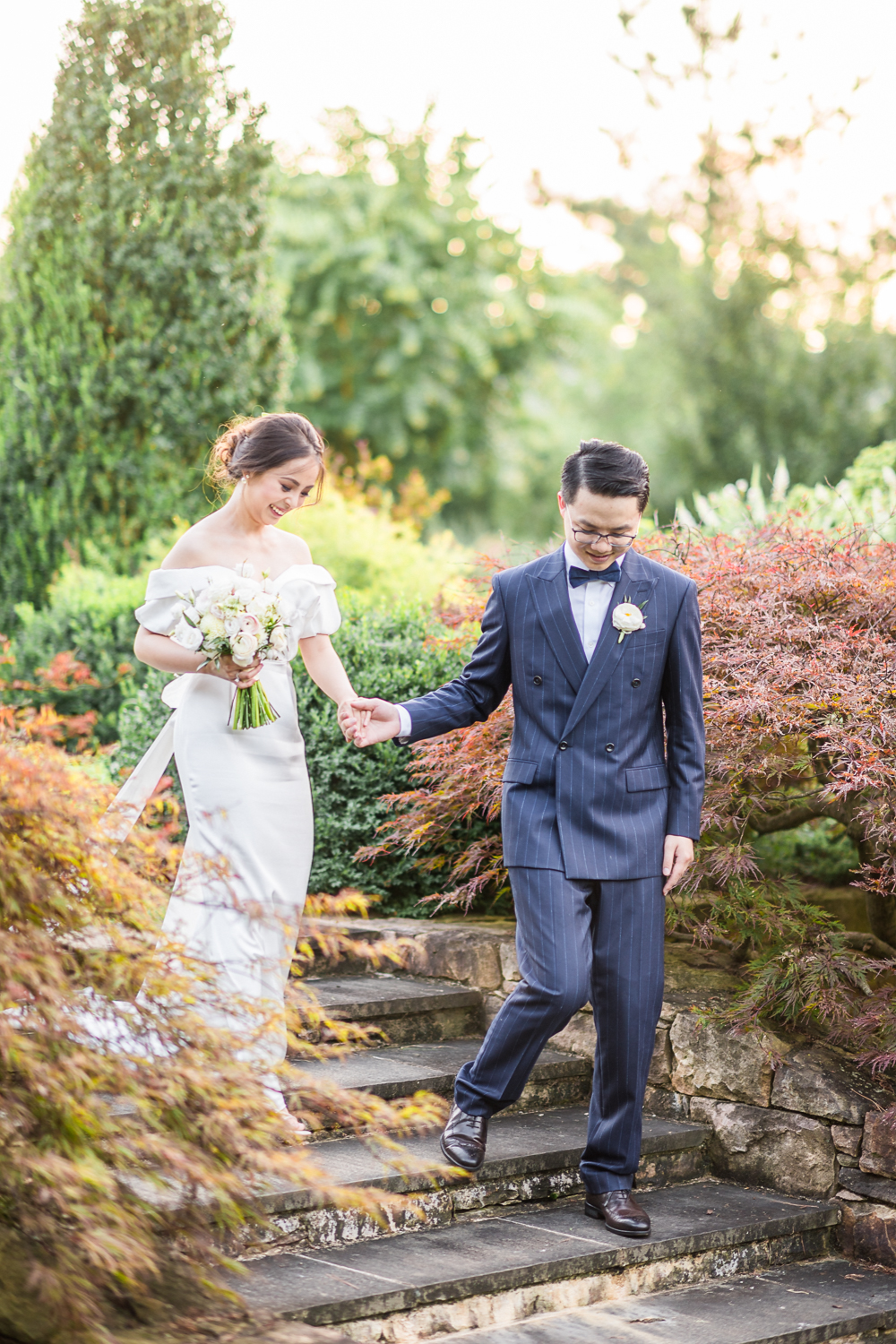
Make the Leap: How to Quit Your Day Job and Become a Full-Time Photographer, Part 4
April 19, 2021
Hey Photographers! It’s been years since I first walked away from my full-time job and entered the world of full-time self-employment. Since then, our photography business has grown, and we began the Hunter and Sarah Photography Apprenticeship, a program where we train newer photographers in their photography and business.
After running the program for a couple of years now, several of our Apprentices have made — or are currently making — the transition from successful side-hustle into full-time professional photographer. Not only have we made that transition ourselves, but now that we’ve helped others make it too, we feel like we have a lot of wisdom to share! That’s why, over the next several weeks, we’re going to be writing a blog series all about quitting your day job and becoming a full-time wedding photographer! And even if full-time isn’t the goal (or it isn’t the goal yet), we still think the tips will help you grow your business!
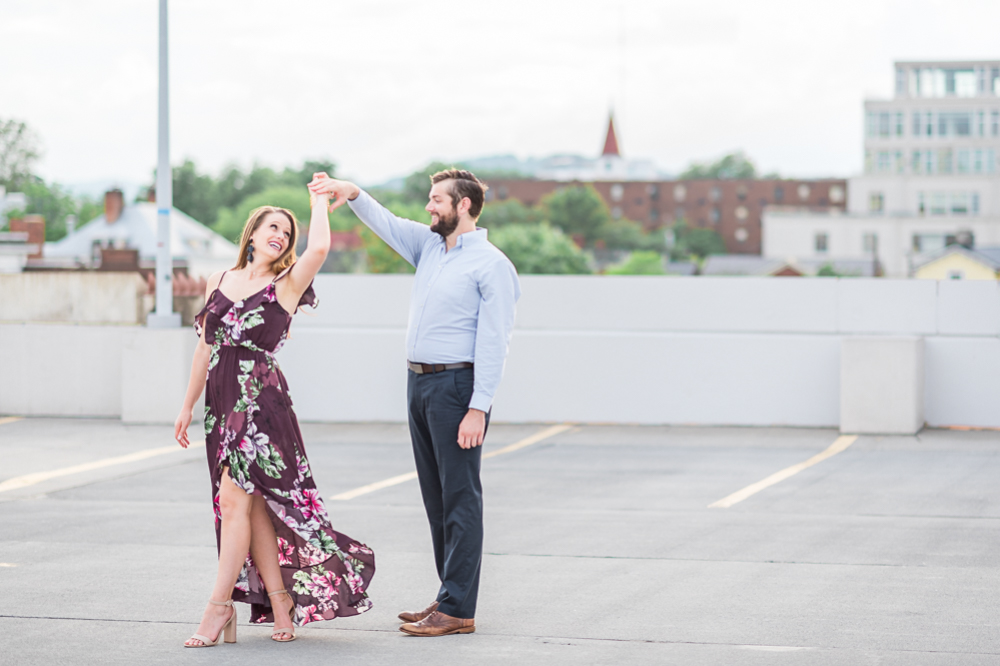
Make the Leap, Part 4: Get BUSY
This may seem obvious, but one of the most important steps to quitting your day job and going full-time with photography is getting busy. Like, REALLY busy. Especially if you don’t have a partner, spouse, parent, or big beefy savings account that can support you financially for several months as you get started. The last thing you want is to quit your job to pursue photography, only to hit a wall a couple of months later and have to go back to the old job, or start waiting tables to make ends meet! So let’s talk about getting busy.
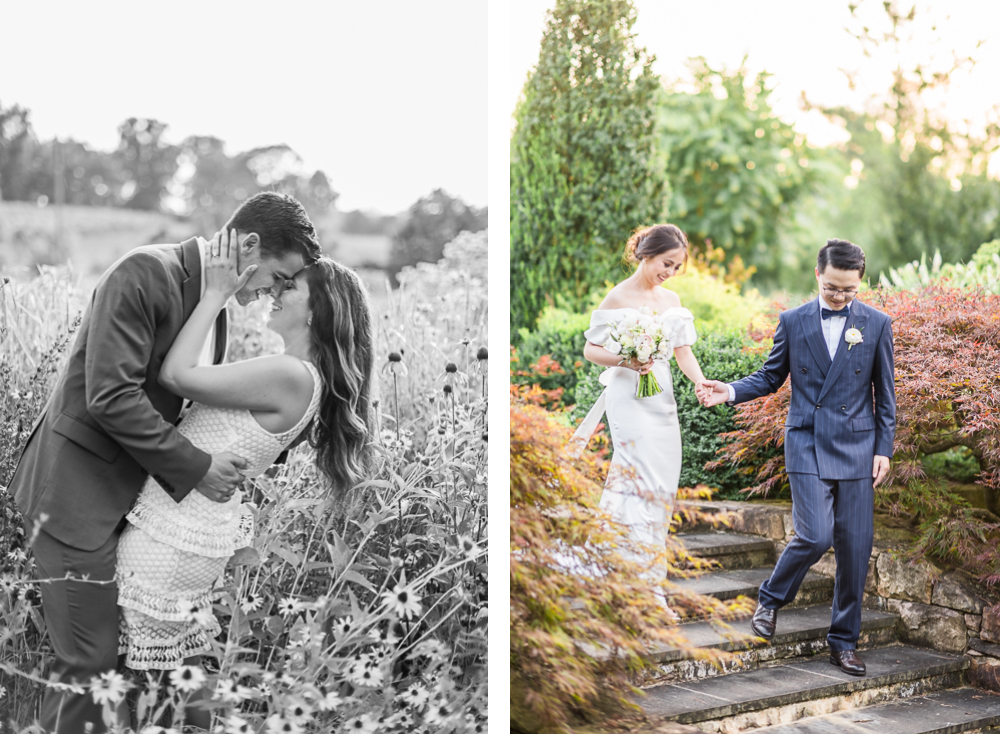
1. Two Full-Time Jobs?!
If you’re working full-time while building up your photography business, this almost definitely means there will be a period of absolute insanity in the month or two leading up to quitting. Since you can’t get your photography business from 5-10 hours per week to 30-40 hours per week overnight, there’s a natural “ramp-up” phase. Here’s how it worked when I went full-time:
Sarah and I decided that I would quit my job and pursue photography full-time about 4 or 5 months before I made the leap. Up until that time, I was consistently working 10-20 hours each week in our photography side-hustle. But when the time came for me to quit, I wanted that number to be closer to 40 hours each week, so I could make enough money to help support our family. So that meant that each month leading up to quitting, I had to ramp up my work in our photography business by a few hours each week, so that when that leap finally came, I wasn’t scrambling around trying to find enough work to cover the bills.
The image below is a visual example of how this might work. The blue line is a constant 40 hours per week job, which you decide you’ll quit on September 1st (so the blue line suddenly goes to zero). The orange line — your photography side-hustle — is flat at 12 hours per week at the start of the year. However, in March, you decide that you’re going to quit on September 1st, and that orange bar is going to be your only source of income. Ideally, by the time that day comes, your photography job will be busy enough to fill your weekly calendar.
The take-away from this chart? By May, you’re working 60 hours per week. And in the month of August, as you’re making final preparations to quit, you’re working nearly 80 hours every week. For many young photographers, this is the path to full-time.

However, there is another way. Compare that last chart to the one below. The photographer above might think in March, “Oh man, my photography side-hustle is going well, so I’ll quit right now and business will pick up as I have more time to invest in the business!” The monthly increase on the orange line (the growth of the photography business) is the same in both charts, but how do you think this second photographer feels about their bank account in April, May and June? Probably pretty stressed, right?
And another thing to consider: in the first scenario (above), all the money their photography business makes in March through August can be reinvested in new camera equipment, computers, etc. But the person below is squeezing every dollar from their business all Spring and Summer to pay their bills! At the end of the year, the person above is a bit more tired from all the hard work, but in a WAY better place financially, in their personal life and in their business.
However, if you have a spouse or partner with a good job that can cover most of your household expenses, that changes everything. And especially if you have kids at home, the prospect of ramping up your full-time-job-plus-photography-business to 80 hours each week is totally impossible. If you’re lucky enough to have a partner with a well-paying job who supports your leap to full-time photographer, that’s great! The chart below may be your path forward. But if you’re single, and especially if you’re still working on getting your personal finances is order, the path below may just spell stress and worry.
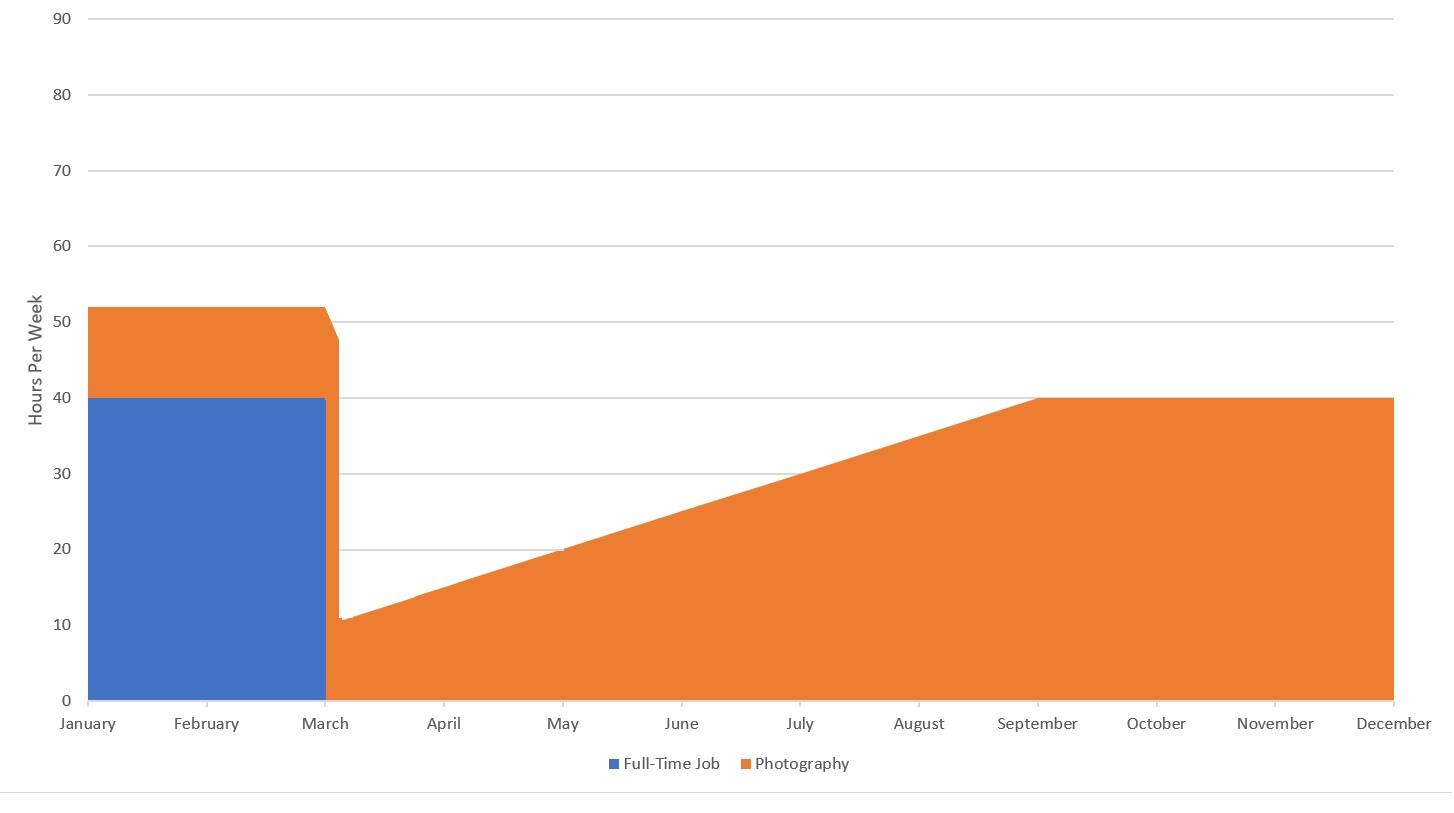
2. More Work Does Not Always Equal More Profit
Of course, that entire example has one very important underlying assumption: more hours per week translates into more dollars made. This seems intuitive, but isn’t always the case. If you go from 10 hours per week to 20 hours per week by spending twice as long editing every photoshoot, you’ll work twice as hard for the same amount of money! But if you go from 10 to 20 hours per week by shooting, editing, and delivering twice as many sessions, that will obviously translate to twice as much money.
This is where the old adage, “work smarter, not harder” comes into play. However, if you want to go from a nice little side job 10 or 15 hours per week to running a business that pays for your entire life, you’ll have to do both. Working smarter without working any harder will make you more efficient, without making you any more profitable. Working harder without working smarter will make you discouraged and less profitable at the same time! But working harder AND smarter is bound to help you build a successful business.
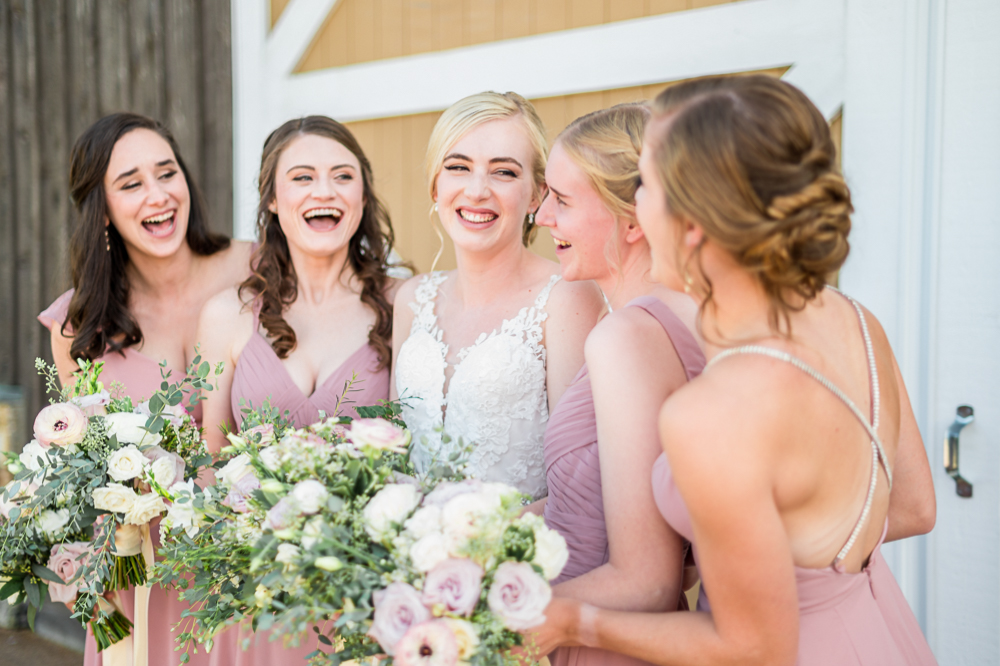
3. There Will Be Hustle
In his book, Quitter, Closing the Gap Between Your Day Job & Your Dream Job, Jon Acuff gives some practical examples about how you can possibly put time and energy (especially anything close to 40 hours per week) into your dream job while still working your day job. Sarah and I both drew on some of these ideas before quitting our full-time jobs for photography, so we think they’re absolutely worth mentioning.
For starters, there’s the practical question of where you can possibly find the time. For Jon (and myself), the mornings are — unfortunately — the answer. If you wait until you get home from work to hustle on your photography business, you’re way more likely to be tired, busy, make excuses, or all three. But if your alarm goes off at 5:30 and you get out of bed, get ready for the day, and sit down at your desk a full 2+ hours before you have to go into work, I doubt you’ll find the temptation to lay down on the couch and watch Netflix with your partner (who is definitely still asleep) quite so tempting. For young parents, the couple of hours between your kiddo’s bed time and when you finally head to sleep is another source of time. And of course… weekends. Especially for budding wedding photographers, get used to seeing your friends on weeknights, or maybe barely at all during this “ramp-up phase”.
However, in the same breath as talking about hustling, 80-hour weeks, and burning the midnight oil, we also want to talk about self-care and rest. We wrote a blog a couple of years ago called “Halt the Hustle“, and the tl;dr is this: it’s absolutely crucial for your business for you to take regular times of rest, or you’ll get burnt out and won’t last for very long. In a seasonal business like photography, there will of course be seasons of more intense work than others (most years, that’s May, June, September and October). But even in the midst of those busy seasons, or in the midst of the “ramp up” phase we were talking about, do everything you can to take regular times of rest. Sarah and I learned the hard way that when we don’t take one day off each week – a Sabbath day – we get irritable, less productive, and exhausted down to our bones. We know that we’ll do way better working six 10-hour days each week than working 8 hour days, every day, without an end in sight!
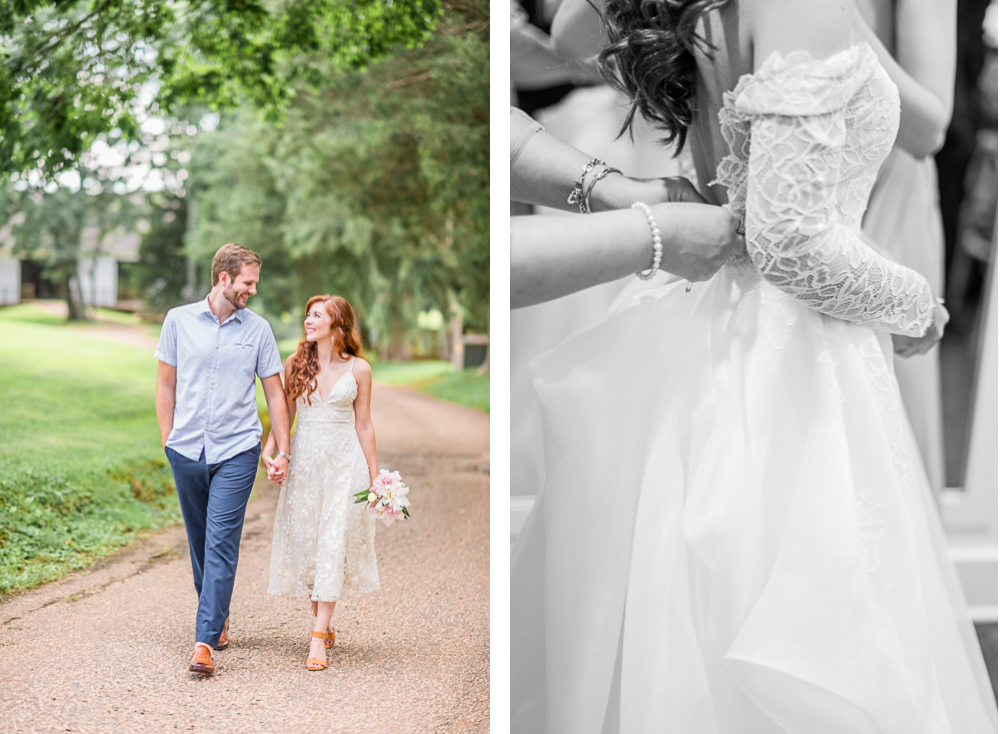
Thanks for reading! Next week we’re going to help you figure out whether or not you’re ready to quit your job. But until then, get hustling!
—
Check out the other segments in this blog series!
- Make the Leap Part 1: Establish Consistency in Your Business
- Make the Leap Part 2: Build a Strong Personal Financial Foundation
- Make the Leap Part 3: Build Your Arsenal of Gear (Debt-Free!)
- Make the Leap Part 4: Get BUSY
- Make the Leap Part 5: How to Know If You’re Ready to Quit Your Job
Want More?
Click HERE to get your free copy of our eBook: “5 Essential Tips for Turning your Side-Hustle into a Full-Time Photography Business.” You’ll also be subscribed to our newsletter, so our newest content, weekly encouragement, and exclusive offers will be delivered right to your inbox!
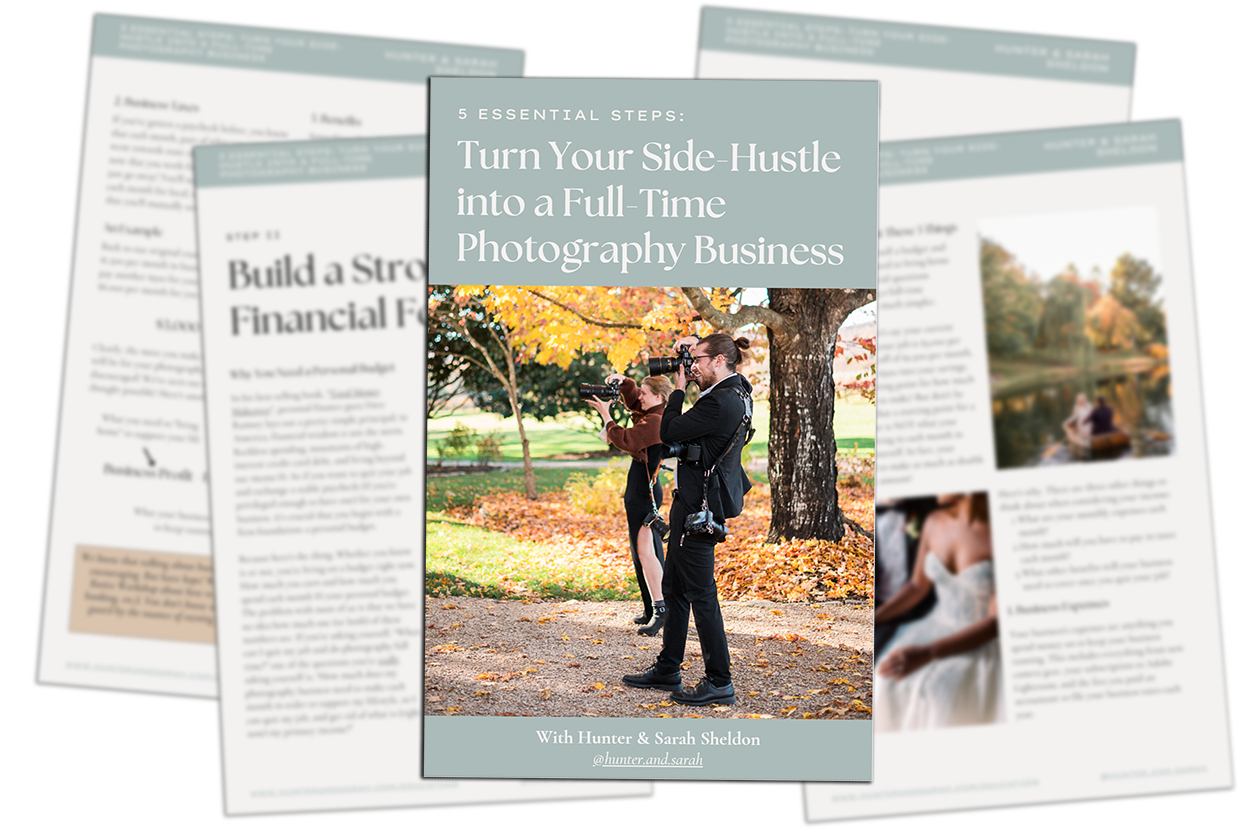
Filed in:
Wedding Photography & Photography Education
Charlottesville, Virginia and Beyond
HOME
ABOUT US
WEDDINGS
JOURNAL
FOR PHOTOGRAPHERS
PRESS & PRAISE
BLOG
CONTACT
e. hunter@hunterandsarahphotography.com
p. (434) 260-0902
